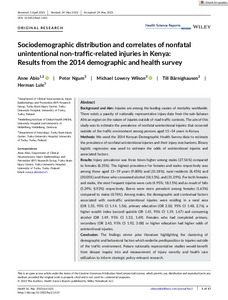Sociodemographic distribution and correlates of nonfatal unintentional non-traffic-related injuries in Kenya: Results from the 2014 demographic and health survey
Abio Anne; Ngum Peter; Wilson Lowery Michael; Bärnighausen Till; Lule Herman
https://urn.fi/URN:NBN:fi-fe2025082787874
Tiivistelmä
Background and aim: Injuries are among the leading causes of mortality worldwide. There exists a paucity of nationally representative injury data from the sub-Saharan African region on the nature of injuries outside of road traffic contexts. The aim of this study was to estimate the prevalence of nonfatal unintentional injuries that occurred outside of the traffic environment among persons aged 15-54 years in Kenya.
Methods: We used the 2014 Kenyan Demographic Health Survey data to estimate the prevalence of nonfatal unintentional injuries and their injury mechanisms. Binary logistic regression was used to estimate the odds of unintentional injuries and associated factors.
Results: Injury prevalence was three times higher among males (27.56%) compared to females (8.25%). The highest prevalence for females and males respectively was among those aged 15-19 years (9.80%) and (31.18%), rural residents (8.45%) and (30.05%) and those who consumed alcohol (18.13%), and (31.39%). For both females and males, the most frequent injuries were cuts (4.95%; 18.15%) and as result of falls (3.29%; 8.92%) respectively. Burns were more prevalent among females (1.65%) compared to males (0.76%). Among males, the demographic and contextual factors associated with nontraffic unintentional injuries were residing in a rural area (OR 1.33, 95% CI 1.14, 1.56), primary education (OR 2.02, 95% CI 1.48, 2.76), a higher wealth index (second quintile OR 1.41, 95% CI 1.19, 1.67) and consuming alcohol (OR 1.49, 95% CI 1.32, 1.69). Females who had completed primary, secondary (OR 2.43, 95% CI 1.92, 3.08) or higher education had higher odds of unintentional injuries.
Conclusion: The findings mirror prior literature highlighting the clustering of demographic and behavioral factors which underlie predisposition to injuries outside of the traffic environment. Future nationally representative studies would benefit from deeper inquiry into and measurement of injury severity and health care utilization to inform strategic policy-relevant research.
Kokoelmat
- Rinnakkaistallenteet [27094]
